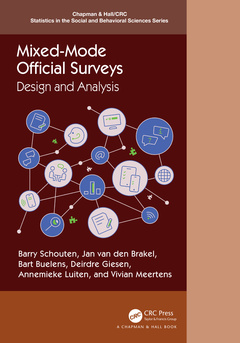Description
Mixed-Mode Official Surveys
Design and Analysis
Chapman & Hall/CRC Statistics in the Social and Behavioral Sciences Series
Authors: Schouten Barry, van den Brakel Jan, Buelens Bart, Giesen Deirdre, Luiten Annemieke, Meertens Vivian
Language: English
Subjects for Mixed-Mode Official Surveys:
Keywords
Mixed Mode Design; multiple survey modes; Mixed Mode Surveys; questionnaire design; Adaptive Survey Designs; mode-specific error; Mixed Mode Survey Design; questionnaire analysis; GREG Estimator; inference procedures; Survey Mode; survey design; Sampling Units; Self-administered Modes; Mode Effects; Web Survey; CAPI; Statistics Netherlands; Data Collection Mode; Interviewer Modes; Measurement Error Model; Auxiliary Variables; Survey Errors; Fay Herriot Model; Benchmark Mode; Measurement Bias; Unconditional Incentive; Selection Effects; Total Survey Error; Answer Behavior; Concurrent Design
57.55 €
In Print (Delivery period: 14 days).
Add to cartPublication date: 09-2023
· 17.8x25.4 cm · Paperback
135.96 €
In Print (Delivery period: 14 days).
Add to cartPublication date: 09-2021
· 17.8x25.4 cm · Hardback
Description
/li>Contents
/li>Biography
/li>
Mixed-mode surveys have become a standard at many statistical institutes. However, the introduction of multiple modes in one design goes with challenges to both methodology and logistics. Mode-specific representation and measurement differences become explicit and demand for solutions in data collection design, questionnaire design, and estimation. This is especially true when surveys are repeated and are input to long time series of official statistics. So how can statistical institutes deal with such changes? What are the origins of mode-specific error? And how can they be dealt with? In this book, the authors provide answers to these questions, and much more.
Features
- Concise introduction to all the key elements of mixed-mode survey design and analysis
- Realistic official statistics examples from three general population surveys
- Suitable for survey managers and survey statisticians alike
- An overview of mode-specific representation and measurement errors and how to avoid, reduce and adjust them.
1. Foreword to Mixed-Mode Official Surveys: Design and Analysis
2. Designing mixed-mode surveys
3. Mode-specific measurement effects
4. Mode-specific selection effects
5. Mixed-mode data collection design
6. Mixed-mode questionnaire design
7. Field tests and implementation of mixed-mode surveys
8. Re-interview designs to disentangle and adjust for mode effects
9. Mixed-mode data analysis
10. Multi-device surveys
11. Adaptive mixed-mode survey designs
12. The future of mixed-mode surveys
13. References
Bart Buelens – Bart Buelens has worked in data analytics after graduating in mathematics and obtaining a PhD in computer science. As statistician and data scientist at Statistics Netherlands he conducted research on inference in mixed-mode surveys, model-based estimation and machine learning. In 2018 he moved to VITO, a Belgian research and technology organization, where he contributes to data science research in the area of sustainability with emphasis on applied artificial intelligence.
Jan van den Brakel – After finishing a Master in Biometrics, Jan van den Brakel started as a junior methodologist at the Methodology Department of Statistics Netherlands in 1994. Based on his research work at Statistics Netherlands on design-based inference methods for randomized experiments embedded in probability samples he finalized his PhD in Statistics in 2001. In 2005 he became senior methodologist, responsible for coordinating research into model based inference methods. Since 2010 he is an Extended professor of Survey Methodology at Maastricht University. His research interest are sampling, design and analysis of experiments, small area estimation, time series analysis and statistical methods for measuring the effects of redesigns of repeated surveys.
Deirdre Giesen – Deirdre Giesen holds a master in health sciences and in sociology. She has worked as a survey methodologist at Statistics Netherlands since 2000. She is a senior methodologist and responsible for coordination of cognitive lab/userlab tests at Statistics Netherlands. Part of her work is pre-testing and evaluating questionnaires, both for businesses and household surveys. Her research interests include questionnaire testing methodology, mixed-mode mixed-device questionnaire development and the measurement and reduction of response burden.
Annemieke Luiten - Annemieke Luiten holds a Master in psychology and a PhD in survey methodology. She is a senior methodologist at Statistics Netherlands
These books may interest you

Handbook of Web Surveys 159.87 €



